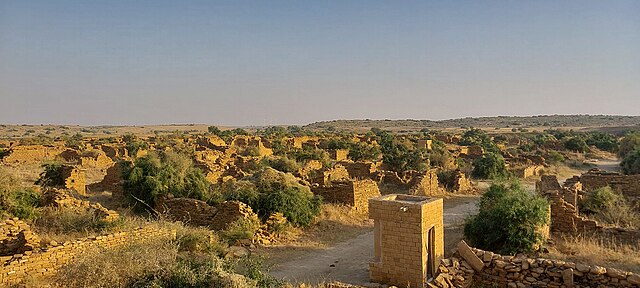Explore haunting Indian ghost towns where history, mystery, and silence converge.

There is something about ghost towns that stirs something deep within us, perhaps it is the faint whispers of once-thriving communities, their laughter, love and loss; their ambition and their decline. Visiting these ruined towns is also an act of remembrance as much as it is an excursion. There is a haunting beauty in walking streets that now stand hushed, overtaken by nature, left to the mercy of time.
Here are 3 ghost towns of India, telling us stories of their life and ruin.
Kuldhara, Rajasthan
Nestled in the golden sands of Rajasthan, just a short drive from the vibrant city of Jaisalmer, lies Kuldhara, an abandoned village that has stood frozen in time for nearly two centuries. This ghost settlement and the cluster of ruins are now shrouded in the legends and mysteries around them. As you step onto its sunbaked paths and wander among the crumbling sandstone walls and roofless homes, you are enveloped by a profound silence, broken only by the whispers of folklore and the echoes of a once-thriving community
Founded in the 13th century, Kuldhara was founded by the Paliwal Brahmins, who were renowned for their mastery of water conservation, as the community was credited for developing the Kund system of water management. A system that is still used today with great effect, even centuries after it was developed.
In 1825, Kuldhara’s story took a dramatic and mysterious turn. According to local legend, the then Diwan of Jaisalmer, Salim Singh, became obsessed with the village chief’s daughter. He issued an ultimatum: surrender the girl or face persecution. Rather than compromise their honour, the entire community, said to number over 1,500 people, vanished overnight, leaving behind a fully functional village. As they departed, they laid a curse upon the land, declaring that no one would ever be able to settle there again. To this day, no one has successfully lived in Kuldhara.
While this tale is the stuff of local folklore, historians also point to possible environmental factors such as dwindling water supplies, prolonged droughts, and harsh living conditions as contributing to the exodus. The truth may never be fully known, but the legend of the curse remains a powerful part of Kuldhara’s mystique. The village’s abandonment is a haunting reminder of the fragility of human settlements in the face of both natural and social challenges.
Kuldhara Today
Today, Kuldhara is a protected monument under the care of the Archaeological Survey of India (ASI) and the State Archaeology Department. Walking through the ruins, you can still see the original layout: straight streets, narrow lanes, and the foundations of homes and temples. The village is devoid of residents, businesses, or overnight stays, its eerie atmosphere drawing history buffs, photographers, and thrill-seekers alike.
The silence of Kuldhara is almost palpable. The wind whistles through empty doorways, and the sun casts long shadows over the crumbling walls. Many visitors report feeling an inexplicable presence or hearing strange noises, fueling rumours of hauntings. While paranormal investigations have yet to uncover definitive proof, the village’s haunted reputation only adds to its allure. Local guides offer captivating storytelling, bringing the legends and history of Kuldhara to life for curious travellers. Their tales weave together fact and folklore, inviting visitors to imagine the lives that once filled these now-empty spaces.
How to Reach
Kuldhara is easily accessible from Jaisalmer, making it a convenient addition to any itinerary in western Rajasthan. The nearest major airport is in Jodhpur, about 290 km away, but Jaisalmer also has a small airport with seasonal flights. For those travelling by train, Jaisalmer Railway Station is well-connected to major cities like Jaipur, Delhi, and Jodhpur. By road, Kuldhara is just 18 km west of Jaisalmer and can be reached by taxi or rental vehicle in under an hour.
Entry & Guidelines
Kuldhara is open daily from 8 AM to 6 PM. Entry fees are modest: approximately ₹10 for Indian nationals and ₹100 for foreign nationals (subject to change). Overnight stays are not permitted within the ruins, so plan your visit accordingly. Be sure to carry water and sun protection, especially during the warmer months, as shade is limited and the desert sun can be intense. Respect the site as a protected monument—avoid climbing on fragile structures or leaving litter behind. Local guides are available and highly recommended for a richer, more immersive experience.
The ideal time to visit Kuldhara is from October to March, when the desert heat is bearable and the sunsets are nothing short of magical. The cool winter months offer comfortable conditions for exploration, and the golden light of dawn and dusk transforms the ruins into a photographer’s dream. Avoid visiting in peak summer (April to June), when temperatures can soar and make outdoor activities challenging.
Kuldhara in Popular Culture
Kuldhara’s legend has captured the imagination of filmmakers, documentarians, and storytellers from around the world. The village has been featured in TV shows, travel documentaries, and paranormal investigations, and its haunting beauty and mysterious aura have made it a popular location for offbeat photoshoots and travel vlogs. Bollywood folklore has also embraced Kuldhara, weaving its legend into films and songs that celebrate Rajasthan’s rich cultural tapestry.
The village’s mystique extends beyond the screen. For photographers, Kuldhara offers endless opportunities to capture the interplay of light, shadow, and history. For writers and artists, it is a source of inspiration—a place where the past is palpable and the stories are as real as the stones beneath your feet.
Netaji Subhash Chandra Bose Island (Ross Island)
Just a short ferry ride from the bustling port city of Port Blair in the Andaman and Nicobar Islands, Netaji Subhash Chandra Bose Island stands as a hauntingly beautiful testament to the rise and fall of colonial ambition and the enduring power of nature to reclaim what man has built. This tiny island, once the glittering heart of British administration in the region, is today a mesmerising blend of crumbling ruins, lush greenery, and vibrant wildlife. For travellers seeking more than just sun and sand, Ross Island offers a unique journey through time, where every vine-covered wall and mossy stone tells a story of empire, resistance, and transformation.
The Colonial Era on Ross Island
Ross Island’s story begins in the mid-19th century, shortly after the British established the infamous Cellular Jail in Port Blair as part of their penal colony for Indian revolutionaries and convicts. Recognising the need for a secure and self-sufficient administrative base, the British chose Ross Island as their headquarters. From 1858 onward, the island became the epicentre of colonial life in the Andamans, a place where British officials, their families, and support staff lived in relative comfort, far removed from the hardships endured by the prisoners just across the water.
The island was soon transformed into a miniature European enclave, earning the nickname “Paris of the East.” Grand bungalows with wide verandas, a Gothic-style church, a ballroom for social gatherings, a bakery, a printing press, and even a tennis court and golf course were constructed amidst carefully landscaped gardens. The British sought to recreate the comforts of home in this remote tropical outpost, and for a time, Ross Island thrived as a symbol of imperial power and prestige.
But the island’s idyllic surface masked a darker reality. Just a short distance away, in the Cellular Jail, Indian prisoners, many of them freedom fighters and political dissidents, endured brutal conditions, forced labour, and isolation. The contrast between the lives of the British elite on Ross Island and the suffering of the prisoners in Port Blair was stark, a reminder of the inequalities and injustices of colonial rule.
Ross Island’s decline began with a 1941 earthquake, followed by Japanese occupation during WWII (1942–1945). Grand colonial buildings were militarised, and new fortifications were built. In December 1943, Subhas Chandra Bose visited, hoisting the Indian flag- this was one of the most significant moments in this island’s history. In 2018, the island was renamed Netaji Subhash Chandra Bose Island.
Ross Island Today
Today, Ross Island is a protected site managed by the Indian Navy, and it stands as one of the most evocative historical destinations in the Andamans. Visitors arriving by ferry are greeted by a scene that seems lifted from a storybook: crumbling stone buildings enveloped in thick vines and strangler figs, their windows and doorways framed by twisting roots. The once-grand bungalows, church, and ballroom are now little more than mossy skeletons of their past.
The island’s transformation is not just a tale of decay, but also of rebirth. As the buildings fell into disrepair, the local flora and fauna moved in. Spotted deer, peacocks, and rabbits now roam freely among the ruins, adding a sense of life and movement to the stillness of the past. The island’s lush greenery and tranquil atmosphere make it a haven for photographers, nature lovers, and anyone seeking a moment of peace away from the crowds.
How To Reach
The island is accessible only by ferry from Aberdeen Jetty in Port Blair, with regular services taking about 15 to 20 minutes each way. Ferries depart throughout the day, but it’s best to book tickets early, especially during peak tourist season.
Entry and Guidelines
Ross Island is open to visitors daily, except on Wednesdays, from 8:00 AM to 3:00 PM. The recommended duration for a visit is two to three hours, allowing ample time to explore the ruins, enjoy the natural surroundings, and soak in the island’s serene atmosphere. Entry fees are modest, with Indian citizens paying around ₹30 and foreign nationals about ₹500. The ferry ticket costs approximately ₹100–₹150 for a round trip, and guided tours are available for those who want to delve deeper into the island’s history.
Comfortable walking shoes are a must, as the paths are uneven and often covered with roots and vines. A water bottle and sun protection are essential, as the tropical sun can be intense. Don’t forget your camera or smartphone—Ross Island is a photographer’s dream, with its blend of ruins, wildlife, and lush greenery. Light snacks are also a good idea, as food options on the island are limited, though there is a small canteen near the jetty.
Overnight stays are not permitted on Ross Island, and the island’s remote location means that mobile network coverage can be patchy. Restrooms are available near the jetty, and the Indian Navy maintains the site with care, ensuring that visitors can enjoy a clean and well-preserved environment.
One of the highlights of a visit to Ross Island is the light and sound show held in the evenings. This captivating performance brings the island’s history to life, narrating the stories of its colonial past, the Japanese occupation, and the brief but significant moment when Subhas Chandra Bose raised the Indian flag. The show is a must-see for anyone interested in the island’s layered history and is available in multiple languages (check locally for schedules).
Ross Island in Popular Culture
Ross Island’s unique blend of history, nature, and mystery has captured the imagination of filmmakers, documentarians, and travellers from around the world. The island has been featured in numerous documentaries, travel shows, and social media posts, earning a reputation as one of the most photogenic and atmospheric destinations in the Andaman. History vloggers and Instagrammers are drawn to its evocative ruins and lush landscapes, while writers and artists find inspiration in its quiet beauty and the stories it holds.
The Indian Navy, which manages much of the island today, plays a vital role in preserving its ruins and natural environment. Their efforts ensure that Ross Island remains a place where visitors can connect with the past, reflect on the impermanence of power, and appreciate the resilience of nature.
Lakhpat, Gujarat
In the heart of Kutch, Lakhpat today stands as a solemn echo of nature’s power and the capricious twists of history. Once a vibrant and wealthy port town, its name, drawn from “Lakhpati,” or millionaire, reflected the prosperity it once commanded, courtesy of its prime position along the trade routes connecting Sindh and Gujarat.
The town thrived on the banks of the Indus River, its fortunes entwined with the steady flow of water and traders that supported bustling trade and fertile farmlands. But everything changed on 16 June 1819, when a powerful earthquake struck the region. Estimated to have a magnitude between 7.7 and 8.2, the quake not only levelled much of the town but also dramatically altered the course of the Indus River. As the river shifted, it left Lakhpat high and dry, cut off, abandoned by trade, and economically parched.
The devastation was widespread, ripping through Kutch and causing massive loss of life and property. For Lakhpat, the disaster was doubly cruel. The river that once nourished its land and people vanished, and with it, the lifeblood of trade and agriculture. The quake also gave rise to the Allah Bund, a natural earthen dam that further disrupted water routes and the region’s ecological balance. As the fields dried and commerce withered, the town’s decline was swift. One by one, families packed up and moved away, seeking survival elsewhere, leaving behind the silent remains of a once-thriving settlement cradled within the imposing walls of Lakhpat Fort.
A Silent Witness to a Lost Era
Today, Lakhpat is a hushed relic of its illustrious past. Its once-busy lanes lie in ghostly stillness, watched over by its grand fortifications, which continue to encircle the town like silent sentinels of history. Constructed in the early 1800s, the fort still stands tall, enclosing within its massive walls a scattering of havelis, mosques, and temples; some in ruins, others fading into the dust. A small number of residents still call Lakhpat home, living in modest conditions, while the rest of the town remains largely deserted. Local lore is rich with tales of curses and legends, further cloaking the town in an aura of mystery that captivates offbeat travellers and seekers of forgotten places.
How to Reach
Reaching Lakhpat requires a journey, but one that is rewarded with haunting beauty and solitude. The town is located about 140 kilometres from Bhuj, the nearest major hub and railway link. Travellers can reach Lakhpat by road; buses and taxis operate on the route, which winds through the stark yet breathtaking landscapes of the Kutch region. Accommodation options within Lakhpat are sparse. Gujarat Tourism runs a guest house, and many visitors opt to stay at the local Gurudwara, which offers basic shelter in exchange for donations. For those seeking more comfort, staying in Bhuj is a practical choice, offering a wider range of hotels and amenities.
Entry and Guidelines
Visitors should come prepared for minimal facilities. Carry essentials like food, water, and cash, as shops and services are extremely limited. The ideal time to explore Lakhpat is between November and February, when the weather is cooler and more conducive for walking tours of the fort and ruins. The town also holds spiritual significance for the Sikh community; Guru Nanak is believed to have visited Lakhpat during his travels. The Gurudwara built in his honour continues to welcome visitors from all faiths
Lakhpat, its fort walls, its wind-swept streets, and its lingering myths offers a rare kind of travel experience: one that doesn’t dazzle with activity but instead invites contemplation, like every other historic town beckoning us to witness it and its story.
Read More: Latest



